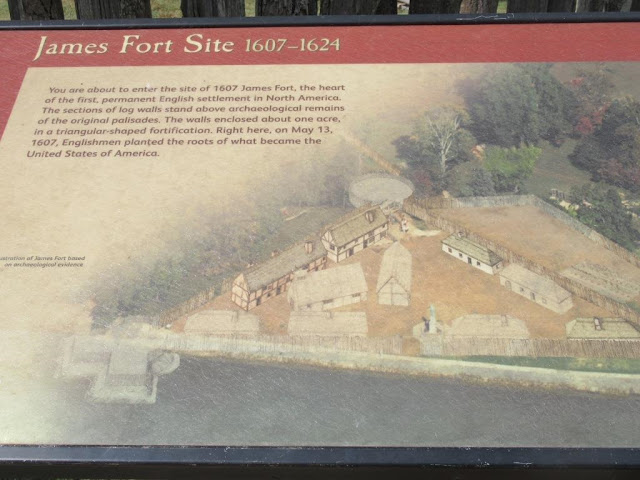With our national parks pass, admission was only $5 per person. The park had an interesting film we watched before touring Jamestown Historic Park.
So now is your first little history lesson. In 1607, three wooden ships, Susan Constant, Godspeed, and Discovery, carried 104 Englishmen and boys across the Atlantic and landed at a tiny island on the river they named the James in honor of the English king. The Powhatan Indians attacked within days of their arrival. The English built a triangular fort for defense. John Smith became the leader of the settlers. This is an illustration of what the acre sized fort looked like from the site excavation.

Once Smith returned to Jamestown, Chief Powhatan sent gifts of food to the starving English. These envoys were usually accompanied by Pocahontas, as she was a sign of peace to the English.

The Werowocomoco, however, got tired of providing food to the settlers, and moved their village further away from the Jamestown colony.
The English had hopes and dreams of finding gold and wealth. In 1608, another group of skilled laborers arrived increasing the settlement’s population to more than 200. Instead of wealth, they suffered many hardships and during the winter of 1609-10 known as the “Starving Time”, all but 60 colonists died by winter’s end.
In 1613, Pocahontas was kidnapped by Captain Samuel Argall and brought to Jamestown. Powhatan, informed of his daughter's capture and ransom cost, agreed to many of the English demands immediately, to open negotiations for her rescue. In the meantime, Pocahontas learned the English language, religion and customs. While not all was strange to Pocahontas, it was vastly different than the Powhatan world.
During her religious instruction, Pocahontas met widower John Rolfe and the two fell in love. John Rolfe was one of the Virginia Colony settlers and is credited with the first successful cultivation of tobacco as an export crop.
In 1614, Pocahontas married John Rolfe resulting in a 7 year peace with the Powhatan Indians.

By 1619, the Virginia Company began sending “maids and poor children” to boost the population. The colony grew and commerce was dependent on tobacco production and export to England. This also led to enslaved Africans being brought to the colony.
We enjoyed all of the historical information at the site, both outdoors on the archaeological site and in the Voorhees Archaearium (museum) and Visitor’s Center.

From the original site, we drove over to Jamestown Settlement, a recreation village, museum and location of three replica ships.
We purchased a combo ticket which includes the Jamestown Settlement and American Revolution Museum at Yorktown.
We started with the 30 minute film then headed outside to see the recreated Powhatan village, ships and James Fort. It was interesting. This is the site that I visited with Tyler 24 years ago! There are “Powhatan” Indians in the site, dressed in costume, showing the activities of the tribe from the 1600s and answering questions.



In the recreated Fort James, again, there were character actors who “lived” in the fort and demonstrated what life would have been like.


We even got to see a black powder musket firing demonstration before heading back to the Galleries to see the inside exhibits and artifacts.

We drove along the Colonial Parkway back to the condo and saw a helicopter hovering near the water on the James River. All we could figure was it was in training as it made several “dip and hover” type moves before circling back and doing it again. Interesting to watch!

We are both tired after our day, so we stopped at the grocery store and picked up some soup for dinner. We are hanging out tonight and will continue our historic tour tomorrow.





